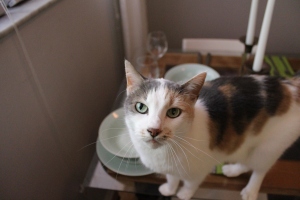The C words
Knowledge is power and one of my favorite forms of knowledge is vocabulary. When I took a field course in Costa Rica for three weeks, studying rainforest animals, I committed to memory three terms that I use often when talking about animals and pets.
In college, I was also taught that one of the best ways to not only remember, but to truly understand a concept is to teach the idea to a friend. This is probably one of the reasons why I still have these three party-worthy words ready to go at a moment’s notice. As soon as I learned them, I began sharing.
Understanding your pet’s behavior directly relates to understanding your pet’s health. Since third grade we have all heard the word nocturnal. Nocturnal animals are those animals that are active during night and sleep during the day. Sugar gliders, rats, hamsters, bats and owls are popular examples. A slightly less known vocabulary word would be the term that describes the opposite: those animals that are active during the day and sleep during the night.
It is silly to think that humans, who are mostly diurnal, seldom know the word for their behavior. There are many examples of diurnal animals, we see them every day when we are awake.
If you can take one thing away from America’s favorite series of vampire-themed fantasies, twilight is not just a bad movie it is an time of day when animals are particularly active. Crepuscular animals are active during twilight, such as dawn and dusk. The word crepuscular is derived from the Latin crepusculum, meaning “twilight.” Knowing if your pets are truly crepuscular might resolve your original thoughts of your animals being lethargic. The more likely answer is that they are active when you are sleeping.
Want to know why your cat starts kneading your eye balls at 5:00am or why your dog starts tugging on your blanket at 5:45am? It has to do with their crepuscular nature.
Hamsters, housecats, dogs, rabbits, ferrets, guinea pigs, hedgehogs and rats might fall into the crepuscular group better then the previously mentioned categories. In a study of stray dogs, the researchers found that most of the dogs were active during dawn and dusk. While most of our house dogs are diurnal, this is likely to be a result of their human activity level.
One advantage of being crepuscular in a hot region is avoiding the sun. Taking a midday siesta can be beneficial to animals, especially if their food sources are also absent. Many animals use the changing of sun to moon or vice versa to feed, look for water, and engage in other behaviors because of the reduced risk of predators. Visibility is challenging, making it easier for animals to hide from potential predators.
To break down activity levels down further, there is another term that we can use to describe our pets: cathemeral. Animals that are cathemeral have very interesting habits. They are active/inactive throughout the 24 hour period. They can be up for 2 hours, then sleep for 4 hours, then up for 10 min, then inactive for 1 hour. Some primates can be described as cathemeral (maybe even humans) and the most famous pet that does this would be the house cat. It gives new meaning to the term “catnap.”
Knowing your pet’s activity will serve as another instrument to assess whether or not animals are stressed, frustrated, or ill.
The last vocab word that I would like to discuss is not related to activity levels but rather eating habits. Coprophagy is the consumption of fecal material. Now, before you put down the paper, I will try to explain why this is important. Unsurprisingly pigs do this, but so do pandas, kolas, kittens, dogs, rabbits, hamsters, kangaroos and chinchillas.
Hamsters, guinea pigs and chinchillas eat their own droppings, which are thought to be a source of vitamins B and K, produced by bacteria in the gut. Animals such as rabbits, are referred to as hindgut fermenters, which digest cellulose (plant material/dietary fiber) with the help of bacteria in their gut. By giving it a second pass through the system, allows better chance for absorption.
Now that you are verbally equipped with new terminology, you can now share this information, retain it and enjoy it at your next formal Sunday brunch.

